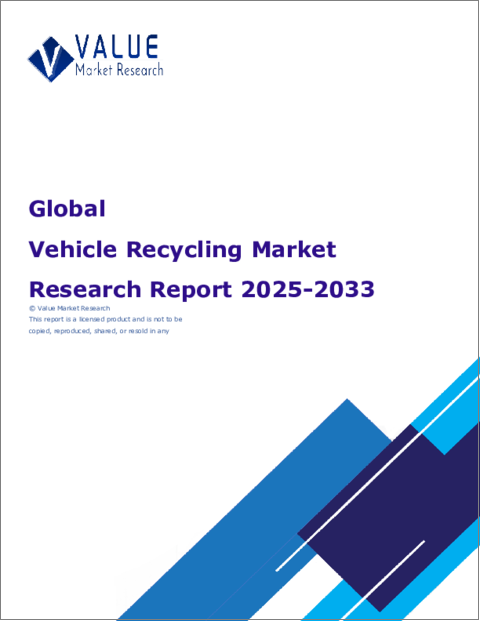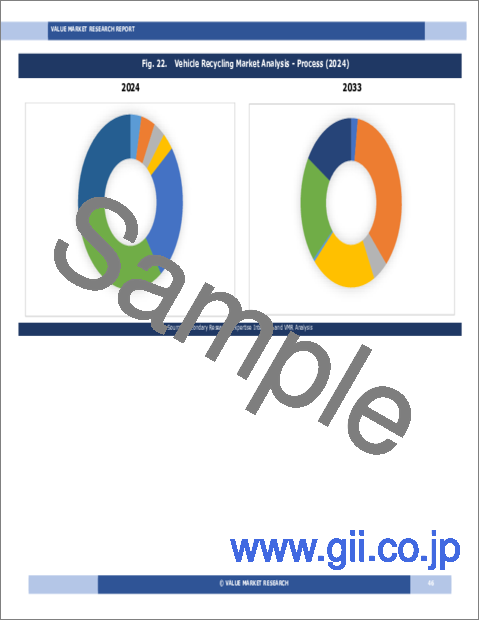|
|
市場調査レポート
商品コード
1683250
自動車リサイクルの世界市場調査レポート:産業分析、規模、シェア、成長、動向、2025年から2033年までの予測Global Vehicle Recycling Market Research Report- Industry Analysis, Size, Share, Growth, Trends and Forecast 2025 to 2033 |
||||||
カスタマイズ可能
|
|||||||
| 自動車リサイクルの世界市場調査レポート:産業分析、規模、シェア、成長、動向、2025年から2033年までの予測 |
|
出版日: 2025年03月01日
発行: Value Market Research
ページ情報: 英文 159 Pages
納期: 即日から翌営業日
|
全表示
- 概要
- 図表
- 目次
自動車リサイクルの世界市場規模は、2024年の339億2,000万米ドルから2033年には631億米ドルに成長し、2026~2033年の予測期間中に7.14%の堅調な年間平均成長率(CAGR)を示すと予測されます。
世界の自動車リサイクル市場は、持続可能性と循環型経済が重視されるようになったことを背景に、大きな成長を遂げようとしています。自動車産業が廃棄物の削減と環境への影響の最小化というプレッシャーの高まりに直面する中、自動車リサイクルは使用済み車両を管理するための重要なソリューションとして浮上してきました。このプロセスは、金属、プラスチック、ガラスなどの貴重な材料を回収するだけでなく、自動車生産に伴う二酸化炭素排出量の削減にも貢献しています。廃棄物管理とリサイクルを取り巻く規制が厳しくなるにつれ、効率的な自動車リサイクルソリューションへの需要が高まり、このセグメントでの技術革新と投資が促進されると予想されます。
さらに、電気自動車(EV)の普及動向は、自動車リサイクル市場をさらに活性化させると考えられます。EVの普及が進むにつれ、リチウムイオンバッテリーやその他の部品の効果的なリサイクルプロセスの必要性が最も重要になります。自動車リサイクル業者は、バッテリー材料の安全なマテリアルハンドリングやリサイクルなど、EVがもたらす特有の課題に対応するために業務を適応させています。このシフトは自動車産業の持続可能性を高めるだけでなく、リサイクル業者にとって電気自動車のニーズに合わせた特殊なプロセスや技術を開発する新たな機会も生み出しています。
さらに、リサイクル技術とプラクティスの継続的な進歩が、自動車リサイクル市場の将来を形成すると予想されます。材料回収プロセスの効率と有効性の向上を目指した革新は、リサイクル率の向上と廃棄物の削減に道を開いています。自動選別システムと先進的破砕技術の開発は、使用済み自動車から貴重な材料を回収する能力を高めています。自動車メーカー、リサイクル企業、規制機関の協力は、自動車リサイクル市場がサステイナブルプラクティスの最前線に立ち続け、より循環型経済に貢献することを確実にするために、これらの進歩を推進する上で不可欠です。
当社のレポートは、様々な産業や市場に関する包括的かつ実用的な洞察を顧客に提供するために、細心の注意を払って作成されています。各レポートは、市場情勢を完全に理解するために、いくつかの重要な要素を含んでいます。
市場概要:市場概要:定義、分類、産業の現状など、市場に関する詳細なイントロダクション。
市場促進要因:市場成長に影響を与える主要促進要因・抑制要因・市場促進要因・課題を詳細に分析します。このセクションでは、技術の進歩、規制の変更、新たな動向などの要因を検証します。
セグメンテーション分析:製品タイプ、用途、エンドユーザー、地域などの基準に基づき、市場を明確なセグメントに内訳。この分析により、各セグメントの業績と将来性を明らかにします。
競合情勢:市場シェア、製品ポートフォリオ、戦略的イニシアティブ、財務実績など、主要市場参入企業の包括的評価。主要企業が採用する競合力学と主要戦略に関する考察を記載しています。
市場予測:過去のデータと現在の市場状況に基づき、一定期間における市場規模と成長動向を予測。これには、定量的分析と将来の市場軌跡を示すグラフ表示が含まれます。
地域分析:地域による市場パフォーマンスを評価し、主要市場や地域動向を明らかにします。地域の市場力学とビジネス機会を理解するのに役立ちます。
新たな動向と機会:現在の市場動向と新たな市場動向、技術革新、潜在的な投資対象セグメントを特定します。将来の市場開拓と成長展望に関する洞察を記載しています。
目次
第1章 序文
第2章 エグゼクティブサマリー
- 市場のハイライト
- 世界市場スナップショット
第3章 自動車リサイクル産業分析
- イントロダクション:市場力学
- 市場促進要因
- 市場抑制要因
- 市場機会
- 産業動向
- ポーターのファイブフォース分析
- 市場の魅力分析
第4章 バリューチェーン分析
- バリューチェーン分析
- 原料分析
- 原料リスト
- 原料メーカー一覧
- 主要原料の価格動向
- 潜在的バイヤーリスト
- マーケティングチャネル
- 直接マーケティング
- 間接マーケティング
- マーケティングチャネル発展動向
第5章 自動車リサイクルの世界市場分析:車種別
- 車種別概要
- 車種別過去・予測データ分析
- 乗用車
- 小型商用車
- 大型商用車
第6章 自動車リサイクルの世界市場分析:材料別
- 材料別概要
- 材料別過去・予測データ分析
- 金属
- ポリマー
- ガラス
- ゴム
- その他
第7章 自動車リサイクルの世界市場分析:プロセス別
- プロセス別概要
- プロセス別過去・予測データ分析
- 解体
- シュレッダー
- リサイクル
- その他
第8章 自動車リサイクルの世界市場分析:用途別
- 用途別概要
- 用途別過去・予測データ分析
- OEM
- アフターマーケット
第9章 自動車リサイクルの世界市場分析:地域別
- 地域別展望
- イントロダクション
- 北米売上分析
- 概要、実績と予測
- 北米:セグメント別
- 北米:国別
- 米国
- カナダ
- メキシコ
- 欧州売上分析
- 概要、実績と予測
- 欧州:セグメント別
- 欧州:国別
- 英国
- フランス
- ドイツ
- イタリア
- ロシア
- その他の欧州
- アジア太平洋売上分析
- 概要、実績と予測
- アジア太平洋:セグメント別
- アジア太平洋:国別
- 中国
- インド
- 日本
- 韓国
- オーストラリア
- 東南アジア
- その他のアジア太平洋
- ラテンアメリカ売上分析
- 概要、実績と予測
- ラテンアメリカ:セグメント別
- ラテンアメリカ:国別
- ブラジル
- アルゼンチン
- ペルー
- チリ
- その他のラテンアメリカ
- 中東・アフリカ売上分析
- 概要、実績と予測
- 中東・アフリカ:セグメント別
- 中東・アフリカ:国別一覧
- サウジアラビア
- アラブ首長国連邦
- イスラエル
- 南アフリカ
- その他の中東・アフリカ
第10章 自動車リサイクル企業の競合情勢
- 自動車リサイクル市場の競合
- 提携・協力・契約
- 合併・買収
- 新製品発表
- その他の開発
第11章 企業プロファイル
- 上位企業の市場シェア分析
- 市場集中度
- LKQ Corporation
- Sims Metal Management Limited
- Schnitzer Steel Industries Inc.
- Toyota Tsusho Corporation
- European Metal Recycling Limited
- Scholz Recycling GmbH
- SA Recycling LLC
- Cox Automotive Inc.
- Fenix Parts Inc.
- Tata Steel Limited
- Liberty Iron & Metal Holdings LLC
- GDE Groupe
- Kuusakoski Oy
- Arnold Clark Automobiles Limited
- Stena Metall AB
LIST OF TABLES
- Market Snapshot
- Drivers: Impact Analysis
- Restraints: Impact Analysis
- List of Raw Material
- List of Raw Material Manufactures
- Analysis By Vehicle Type (USD MN)
- Passenger Cars Market Sales By Geography (USD MN)
- Light Commercial Vehicles Market Sales By Geography (USD MN)
- Heavy Commercial Vehicles Market Sales By Geography (USD MN)
- Analysis By Material (USD MN)
- Metals Market Sales By Geography (USD MN)
- Polymers Market Sales By Geography (USD MN)
- Glass Market Sales By Geography (USD MN)
- Rubber Market Sales By Geography (USD MN)
- Others Market Sales By Geography (USD MN)
- Analysis By Process (USD MN)
- Dismantling Market Sales By Geography (USD MN)
- Shredding Market Sales By Geography (USD MN)
- Recycling Market Sales By Geography (USD MN)
- Others Market Sales By Geography (USD MN)
- Analysis By Application (USD MN)
- OEMs Market Sales By Geography (USD MN)
- Aftermarket Market Sales By Geography (USD MN)
- Global Vehicle Recycling Market Sales By Geography (USD MN)
- North America Market Analysis (USD MN)
- United States Market Analysis (USD MN)
- Canada Market Analysis (USD MN)
- Mexico Market Analysis (USD MN)
- Europe Market Analysis (USD MN)
- Europe Market Estimate By Country (USD MN)
- United Kingdom Market Analysis (USD MN)
- France Market Analysis (USD MN)
- Germany Market Analysis (USD MN)
- Italy Market Analysis (USD MN)
- Russia Market Analysis (USD MN)
- Spain Market Analysis (USD MN)
- Rest of Europe Market Analysis (USD MN)
- Asia Pacific Market Analysis (USD MN)
- China Market Analysis (USD MN)
- Japan Market Analysis (USD MN)
- India Market Analysis (USD MN)
- South Korea Market Analysis (USD MN)
- Australia Market Analysis (USD MN)
- South East Asia Market Analysis (USD MN)
- Rest of Asia Pacific Market Analysis (USD MN)
- Latin America Market Analysis (USD MN)
- Brazil Market Analysis (USD MN)
- Argentina Market Analysis (USD MN)
- Peru Market Analysis (USD MN)
- Chile Market Analysis (USD MN)
- Rest of Latin America Market Analysis (USD MN)
- Middle East & Africa Market Analysis (USD MN)
- Saudi Arabia Market Analysis (USD MN)
- UAE Market Analysis (USD MN)
- Israel Market Analysis (USD MN)
- South Africa Market Analysis (USD MN)
- Rest of Middle East and Africa Market Analysis (USD MN)
- Partnership/Collaboration/Agreement
- Mergers And Acquisition
LIST OF FIGURES
- Research Scope of Vehicle Recycling Report
- Market Research Process
- Market Research Methodology
- Global Vehicle Recycling Market Size, By Region (USD MN)
- Porters Five Forces Analysis
- Market Attractiveness Analysis By Vehicle Type
- Market Attractiveness Analysis By Material
- Market Attractiveness Analysis By Process
- Market Attractiveness Analysis By Application
- Market Attractiveness Analysis By Region
- Value Chain Analysis
- Global Market Analysis By Vehicle Type (USD MN)
- Passenger Cars Market Sales By Geography (USD MN)
- Light Commercial Vehicles Market Sales By Geography (USD MN)
- Heavy Commercial Vehicles Market Sales By Geography (USD MN)
- Global Market Analysis By Material (USD MN)
- Metals Market Sales By Geography (USD MN)
- Polymers Market Sales By Geography (USD MN)
- Glass Market Sales By Geography (USD MN)
- Rubber Market Sales By Geography (USD MN)
- Others Market Sales By Geography (USD MN)
- Global Market Analysis By Process (USD MN)
- Dismantling Market Sales By Geography (USD MN)
- Shredding Market Sales By Geography (USD MN)
- Recycling Market Sales By Geography (USD MN)
- Others Market Sales By Geography (USD MN)
- Global Market Analysis By Application (USD MN)
- OEMs Market Sales By Geography (USD MN)
- Aftermarket Market Sales By Geography (USD MN)
- Global Market Sales (USD MN)
- North America Market Sales (USD MN)
- Europe Market Sales (USD MN)
- Asia Pacific Market Sales (USD MN)
- Latin America Market Sales (USD MN)
- Middle East & Africa Market Sales (USD MN)
- Recent Development in Industry
- Top Company Market Share Analysis
Kindly note that the above listed are the basic tables and figures of the report and are not limited to the TOC.
Global Vehicle Recycling Market size is anticipated to grow from USD 33.92 Billion in 2024 to USD 63.1 Billion by 2033, showcasing a robust Compound Annual Growth Rate (CAGR) of 7.14% during the forecast period of 2026 to 2033.
The global vehicle recycling market is poised for significant growth, driven by the increasing emphasis on sustainability and the circular economy. As the automotive industry faces mounting pressure to reduce waste and minimize environmental impact, vehicle recycling has emerged as a critical solution for managing end-of-life vehicles. The process not only recovers valuable materials such as metals, plastics, and glass but also contributes to reducing the carbon footprint associated with vehicle production. As regulations surrounding waste management and recycling become more stringent, the demand for efficient vehicle recycling solutions is expected to rise, fostering innovation and investment in this sector.
Moreover, the growing trend of electric vehicles (EVs) is set to further boost the vehicle recycling market. As the adoption of EVs increases, the need for effective recycling processes for lithium-ion batteries and other components becomes paramount. Vehicle recyclers are adapting their operations to accommodate the unique challenges posed by EVs, including the safe handling and recycling of battery materials. This shift not only enhances the sustainability of the automotive industry but also creates new opportunities for recyclers to develop specialized processes and technologies tailored to the needs of electric vehicles.
In addition, ongoing advancements in recycling technologies and practices are expected to shape the future of the vehicle recycling market. Innovations aimed at improving the efficiency and effectiveness of material recovery processes are paving the way for higher recycling rates and reduced waste. The development of automated sorting systems and advanced shredding technologies is enhancing the ability to recover valuable materials from end-of-life vehicles. Collaborative efforts between automotive manufacturers, recycling companies, and regulatory bodies will be essential in driving these advancements, ensuring that the vehicle recycling market remains at the forefront of sustainable practices and contributes to a more circular economy.
Our reports are meticulously crafted to provide clients with comprehensive and actionable insights into various industries and markets. Each report encompasses several critical components to ensure a thorough understanding of the market landscape:
Market Overview: A detailed introduction to the market, including definitions, classifications, and an overview of the industry's current state.
Market Dynamics: In-depth analysis of key drivers, restraints, opportunities, and challenges influencing market growth. This section examines factors such as technological advancements, regulatory changes, and emerging trends.
Segmentation Analysis: Breakdown of the market into distinct segments based on criteria like product type, application, end-user, and geography. This analysis highlights the performance and potential of each segment.
Competitive Landscape: Comprehensive assessment of major market players, including their market share, product portfolio, strategic initiatives, and financial performance. This section provides insights into the competitive dynamics and key strategies adopted by leading companies.
Market Forecast: Projections of market size and growth trends over a specified period, based on historical data and current market conditions. This includes quantitative analyses and graphical representations to illustrate future market trajectories.
Regional Analysis: Evaluation of market performance across different geographical regions, identifying key markets and regional trends. This helps in understanding regional market dynamics and opportunities.
Emerging Trends and Opportunities: Identification of current and emerging market trends, technological innovations, and potential areas for investment. This section offers insights into future market developments and growth prospects.
SEGMENTATION COVERED IN THE REPORT
By Vehicle Type
- Passenger Cars
- Light Commercial Vehicles
- Heavy Commercial Vehicles
By Material
- Metals
- Polymers
- Glass
- Rubber
- Others
By Process
- Dismantling
- Shredding
- Recycling
- Others
By Application
- OEMs
- Aftermarket
- COMPANIES PROFILED
- LKQ Corporation
- Sims Metal Management Limited
- Schnitzer Steel Industries Inc.
- Toyota Tsusho Corporation
- European Metal Recycling Limited
- Scholz Recycling GmbH
- SA Recycling LLC
- Cox Automotive Inc.
- Fenix Parts Inc.
- Tata Steel Limited
- Liberty Iron & Metal Holdings LLC
- GDE Groupe
- Kuusakoski Oy
- Arnold Clark Automobiles Limited
- Stena Metall AB.
- The above list can be customized.
TABLE OF CONTENTS
1. PREFACE
- 1.1. Report Description
- 1.1.1 Objective
- 1.1.2 Target Audience
- 1.1.3 Unique Selling Proposition (USP) & offerings
- 1.2. Research Scope
- 1.3. Research Methodology
- 1.3.1 Market Research Process
- 1.3.2 Market Research Methodology
2. EXECUTIVE SUMMARY
- 2.1. Highlights of Market
- 2.2. Global Market Snapshot
3. VEHICLE RECYCLING INDUSTRY ANALYSIS
- 3.1. Introduction - Market Dynamics
- 3.2. Market Drivers
- 3.3. Market Restraints
- 3.4. Opportunities
- 3.5. Industry Trends
- 3.6. Porter's Five Force Analysis
- 3.7. Market Attractiveness Analysis
- 3.7.1 Market Attractiveness Analysis By Vehicle Type
- 3.7.2 Market Attractiveness Analysis By Material
- 3.7.3 Market Attractiveness Analysis By Process
- 3.7.4 Market Attractiveness Analysis By Application
- 3.7.5 Market Attractiveness Analysis By Region
4. VALUE CHAIN ANALYSIS
- 4.1. Value Chain Analysis
- 4.2. Raw Material Analysis
- 4.2.1 List of Raw Materials
- 4.2.2 Raw Material Manufactures List
- 4.2.3 Price Trend of Key Raw Materials
- 4.3. List of Potential Buyers
- 4.4. Marketing Channel
- 4.4.1 Direct Marketing
- 4.4.2 Indirect Marketing
- 4.4.3 Marketing Channel Development Trend
5. GLOBAL VEHICLE RECYCLING MARKET ANALYSIS BY VEHICLE TYPE
- 5.1. Overview By Vehicle Type
- 5.2. Historical and Forecast Data Analysis By Vehicle Type
- 5.3. Passenger Cars Historic and Forecast Sales By Regions
- 5.4. Light Commercial Vehicles Historic and Forecast Sales By Regions
- 5.5. Heavy Commercial Vehicles Historic and Forecast Sales By Regions
6. GLOBAL VEHICLE RECYCLING MARKET ANALYSIS BY MATERIAL
- 6.1. Overview By Material
- 6.2. Historical and Forecast Data Analysis By Material
- 6.3. Metals Historic and Forecast Sales By Regions
- 6.4. Polymers Historic and Forecast Sales By Regions
- 6.5. Glass Historic and Forecast Sales By Regions
- 6.6. Rubber Historic and Forecast Sales By Regions
- 6.7. Others Historic and Forecast Sales By Regions
7. GLOBAL VEHICLE RECYCLING MARKET ANALYSIS BY PROCESS
- 7.1. Overview By Process
- 7.2. Historical and Forecast Data Analysis By Process
- 7.3. Dismantling Historic and Forecast Sales By Regions
- 7.4. Shredding Historic and Forecast Sales By Regions
- 7.5. Recycling Historic and Forecast Sales By Regions
- 7.6. Others Historic and Forecast Sales By Regions
8. GLOBAL VEHICLE RECYCLING MARKET ANALYSIS BY APPLICATION
- 8.1. Overview By Application
- 8.2. Historical and Forecast Data Analysis By Application
- 8.3. OEMs Historic and Forecast Sales By Regions
- 8.4. Aftermarket Historic and Forecast Sales By Regions
9. GLOBAL VEHICLE RECYCLING MARKET ANALYSIS BY GEOGRAPHY
- 9.1. Regional Outlook
- 9.2. Introduction
- 9.3. North America Sales Analysis
- 9.3.1 Overview, Historic and Forecast Data Sales Analysis
- 9.3.2 North America By Segment Sales Analysis
- 9.3.3 North America By Country Sales Analysis
- 9.3.4 United States Sales Analysis
- 9.3.5 Canada Sales Analysis
- 9.3.6 Mexico Sales Analysis
- 9.4. Europe Sales Analysis
- 9.4.1 Overview, Historic and Forecast Data Sales Analysis
- 9.4.2 Europe By Segment Sales Analysis
- 9.4.3 Europe By Country Sales Analysis
- 9.4.4 United Kingdom Sales Analysis
- 9.4.5 France Sales Analysis
- 9.4.6 Germany Sales Analysis
- 9.4.7 Italy Sales Analysis
- 9.4.8 Russia Sales Analysis
- 9.4.9 Rest Of Europe Sales Analysis
- 9.5. Asia Pacific Sales Analysis
- 9.5.1 Overview, Historic and Forecast Data Sales Analysis
- 9.5.2 Asia Pacific By Segment Sales Analysis
- 9.5.3 Asia Pacific By Country Sales Analysis
- 9.5.4 China Sales Analysis
- 9.5.5 India Sales Analysis
- 9.5.6 Japan Sales Analysis
- 9.5.7 South Korea Sales Analysis
- 9.5.8 Australia Sales Analysis
- 9.5.9 South East Asia Sales Analysis
- 9.5.10 Rest Of Asia Pacific Sales Analysis
- 9.6. Latin America Sales Analysis
- 9.6.1 Overview, Historic and Forecast Data Sales Analysis
- 9.6.2 Latin America By Segment Sales Analysis
- 9.6.3 Latin America By Country Sales Analysis
- 9.6.4 Brazil Sales Analysis
- 9.6.5 Argentina Sales Analysis
- 9.6.6 Peru Sales Analysis
- 9.6.7 Chile Sales Analysis
- 9.6.8 Rest of Latin America Sales Analysis
- 9.7. Middle East & Africa Sales Analysis
- 9.7.1 Overview, Historic and Forecast Data Sales Analysis
- 9.7.2 Middle East & Africa By Segment Sales Analysis
- 9.7.3 Middle East & Africa By Country Sales Analysis
- 9.7.4 Saudi Arabia Sales Analysis
- 9.7.5 UAE Sales Analysis
- 9.7.6 Israel Sales Analysis
- 9.7.7 South Africa Sales Analysis
- 9.7.8 Rest Of Middle East And Africa Sales Analysis
10. COMPETITIVE LANDSCAPE OF THE VEHICLE RECYCLING COMPANIES
- 10.1. Vehicle Recycling Market Competition
- 10.2. Partnership/Collaboration/Agreement
- 10.3. Merger And Acquisitions
- 10.4. New Product Launch
- 10.5. Other Developments
11. COMPANY PROFILES OF VEHICLE RECYCLING INDUSTRY
- 11.1. Top Companies Market Share Analysis
- 11.2. Market Concentration Rate
- 11.3. LKQ Corporation
- 11.3.1 Company Overview
- 11.3.2 Company Revenue
- 11.3.3 Products
- 11.3.4 Recent Developments
- 11.4. Sims Metal Management Limited
- 11.4.1 Company Overview
- 11.4.2 Company Revenue
- 11.4.3 Products
- 11.4.4 Recent Developments
- 11.5. Schnitzer Steel Industries Inc.
- 11.5.1 Company Overview
- 11.5.2 Company Revenue
- 11.5.3 Products
- 11.5.4 Recent Developments
- 11.6. Toyota Tsusho Corporation
- 11.6.1 Company Overview
- 11.6.2 Company Revenue
- 11.6.3 Products
- 11.6.4 Recent Developments
- 11.7. European Metal Recycling Limited
- 11.7.1 Company Overview
- 11.7.2 Company Revenue
- 11.7.3 Products
- 11.7.4 Recent Developments
- 11.8. Scholz Recycling GmbH
- 11.8.1 Company Overview
- 11.8.2 Company Revenue
- 11.8.3 Products
- 11.8.4 Recent Developments
- 11.9. SA Recycling LLC
- 11.9.1 Company Overview
- 11.9.2 Company Revenue
- 11.9.3 Products
- 11.9.4 Recent Developments
- 11.10. Cox Automotive Inc.
- 11.10.1 Company Overview
- 11.10.2 Company Revenue
- 11.10.3 Products
- 11.10.4 Recent Developments
- 11.11. Fenix Parts Inc.
- 11.11.1 Company Overview
- 11.11.2 Company Revenue
- 11.11.3 Products
- 11.11.4 Recent Developments
- 11.12. Tata Steel Limited
- 11.12.1 Company Overview
- 11.12.2 Company Revenue
- 11.12.3 Products
- 11.12.4 Recent Developments
- 11.13. Liberty Iron & Metal Holdings LLC
- 11.13.1 Company Overview
- 11.13.2 Company Revenue
- 11.13.3 Products
- 11.13.4 Recent Developments
- 11.14. GDE Groupe
- 11.14.1 Company Overview
- 11.14.2 Company Revenue
- 11.14.3 Products
- 11.14.4 Recent Developments
- 11.15. Kuusakoski Oy
- 11.15.1 Company Overview
- 11.15.2 Company Revenue
- 11.15.3 Products
- 11.15.4 Recent Developments
- 11.16. Arnold Clark Automobiles Limited
- 11.16.1 Company Overview
- 11.16.2 Company Revenue
- 11.16.3 Products
- 11.16.4 Recent Developments
- 11.17. Stena Metall AB
- 11.17.1 Company Overview
- 11.17.2 Company Revenue
- 11.17.3 Products
- 11.17.4 Recent Developments






